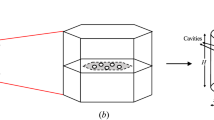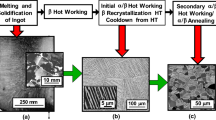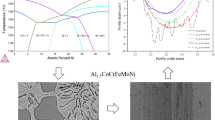Abstract
An experimental investigation has been conducted to study the crack growth characteristics of a 90% pure aluminium oxide in 1050 °C air under static and cyclic loads. It is shown that the application of both sustained and fluctuating tensile loads to the ceramic, tested in a precracked four-point bend specimen configuration, results in appreciable subcritical crack growth. The crack velocities under cyclic loading conditions are up to two orders of magnitude slower than those measured in static loading under the same maximum stress intensity factor. Cyclic crack growth rates are markedly affected by the loading frequency, with a decrease in test frequency causing an increase in the rate of crack advance. Detailed optical and electron microscopy observations have been made in an attempt to study the mechanisms of stable crack growth and the mechanistic differences between static fatigue fracture. Under both static and cyclic loads, the predominant mode of fracture is intergranular separation. The presence of a glass phase along the grain boundaries appears to have a strong effect on the mechanisms of crack growth. Apparent differences in the crack velocities between static and cyclic fatigue in alumina arise from crack-wake contact effects as well as from the rate-sensitivity of deformation of the glass phase. Our results also indicate that the cyclic fatigue crack growth rates cannot be predicted solely on the basis of sustained load fracture data. White stable crack growth occurs in the 90% pure alumina over a range of stress intensity factor spanning 1.5 to 5 MPa m1/2, such subcritical fracture is essentially suppressed in a 99.9% pure alumina, ostensibly due to the paucity of a critical amount of glass phase. Both static and cyclic fracture characteristics of the 90% pure alumina are qualitatively similar to those found in an Al2O3-SiC composite wherein situ formation of glass phases, due to the oxidation of SiC in high-temperature air, is known to be an important factor in the fracture process.
Similar content being viewed by others
References
A. G. Evans andE. R. Fuller,Metall. Trans. 5A (1974) 27.
S. Lathabai, Y.-W. Mai andB. R. Lawn,J. Amer. Ceram. Soc. 72 (1989) 1760.
T. Kawakubo, N. Okabe andT. Mori, in “Fatigue 90”, Vol. 2, edited by H. Kitagawa and T. Tanaka (Materials and Component Engineering Publications Ltd, Birmingham, 1990) p. 717.
J. S. Mizushima andW. J. Knapp,Ceram. News 5 (1956) 26–29, 36.
H. N. Ko,J. Mater. Sci. Lett. 5 (1986) 464.
Idem, ibid. 8 (1989) 1438.
K. C. Liu andC. R. Brinkman, in Proceedings of 24th Automotive Technology Development Contractors' Meeting, P-197 (Society of Automotive Engineers, Warrendale, PA, 1987) p. 191.
L. S. Williams,Trans. Br. Ceram. Soc. 55 (1956) 287.
C. P. Chen andW. J. Knapp, in “Fracture Mechanics of Ceramics”, Vol. 2, edited by R. C. Bradt, D. P. H. Hasselman and F. F. Lange (Plenum, New York, 1974) p. 691.
D. A. Krohn andD. P. H. Hasselman,J. Amer. Ceram. Soc. 55 (1972) 208.
A. G. Evans,Int. J. Fract. 16 (1980) 485.
E. B. Shand,Amer. Ceram. Soc. Bull. 38 (1959) 653.
R. Sedlacek andF. A. Halden, in “Structural Ceramics and Testing of Brittle Materials”, edited by S. J. Acquaviva and S. A. Bortz (Gordon & Breach, New York, 1968) p. 211.
B. K. Sarkar andT. G. J. Quinn,Trans. Br. Ceram. Soc. 69 (1970) 199.
F. Guiu,J. Mater. Sci. Lett. 13 (1978) 1357.
L. Ewart andS. Suresh,ibid. 5 (1986) 774.
Idem, J. Mater. Sci. 22 (1987) 1173.
J. R. Brockenbrough andS. Suresh,J. Mech. Phys. Solids 35 (1987) 721.
S. Suresh andJ. R. Brockenbrough,Acta Metall. 36 (1988) 1455.
S. Suresh, in “Fatigue 90”, Vol. 2, edited by H. Kitagawa and T. Tanaka (Materials and Component Engineering Publications Ltd, Birmingham, 1990) p. 759.
Idem, Int. J. Fract. 42 (1990) 41.
M. J. Reece, F. Guiu andM. F. R. Sammur,J. Amer. Ceram. Soc. 72 (1989) 348.
A. G. Evans, L. R. Russell andD. W. Richerson,Metall. Trans. 6A (1975) 707.
L. X. Han andS. Suresh,J. Amer. Ceram. Soc. 72 (1989) 1233.
L. X. Han, R. Warren andS. Suresh,Acta Metall. Mater. 40 (1992) 259.
L. Ewart, PhD thesis, Brown University (1990).
C. -K. J. Lin andD. F. Socie,J. Amer. Ceram. Soc. 74 (1991) 1511.
T. Fett, G. Himsolt andD. Munz,Adv. Ceram. Mater. 1 (1986) 179.
S. Suresh, “Fatigue of Materials” (Cambridge University Press, Cambridge, England, 1991) pp. 403–56.
R. H. Dauskardt, D. B. Marshall andR. O. Ritchie,J. Amer. Ceram. Soc. 73 (1990) 893.
P. F. Becher andT. N. Tiegs,Adv. Ceram. Mater. 3 (1988) 148.
R. Raj,J. Amer. Ceram. Soc. 69 (1986) 708.
K. Jakus, S. M. Wiederhorn andB. J. Hockey,ibid. 725.
J. R. Porter,Mater. Sci. Engng A107 (1989) 127.
S. W. Freiman, in “Strength of Inorganic Glass”, edited by C. R. Kurkjian (Plenum, New York, 1985) p. 197.
Author information
Authors and Affiliations
Rights and permissions
About this article
Cite this article
Ewart, L., Suresh, S. Elevated-temperature crack growth in polycrystalline alumina under static and cyclic loads. J Mater Sci 27, 5181–5191 (1992). https://doi.org/10.1007/BF00553389
Received:
Accepted:
Issue Date:
DOI: https://doi.org/10.1007/BF00553389




